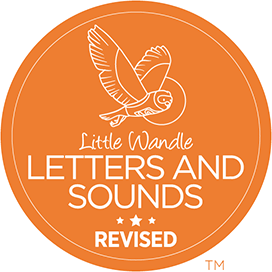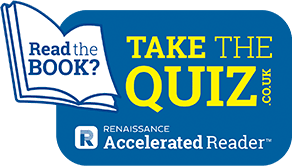Reading Schemes

All pupils visit the school library at least fortnightly to access a free-choice book and the local library several times during the academic year.
|
EYFS and Year 1Little Wandle Letters and Sounds Revised is a complete systematic synthetic phonics programme (SSP) developed for schools by schools. Based on the original Letters and Sounds, but extensively revised to provide a complete teaching programme, meeting all the expectations of the National Curriculum and preparing children to go beyond the expectations of the Phonics Screening Check.
Progression across Reception - Year 1 Pupils in EYFS and Year 1 receive a Little Wandle reading book that matches their current learning and gives pupils an opportunity to apply and consolidate these skills at home. |
Accelerated Reader
|
Accelerated Reader provides teachers with an effective way to monitor all forms of guided reading practice and library circulation. Accelerated Reader provides detailed, objective data to target teaching and ensure success for every pupil, regardless of level, from emergent reader onwards!
Get pupils excited about books: Accelerated Reader helps you focus attention on the careful reading of books, which improves pupils' critical thinking skills and builds an intrinsic love of reading Obtain reliable, objective information: Over 30 reports are available so you can accurately monitor performance and progress towards targets Individualised Learning: Accelerated Reader helps you individualise teaching for every pupil Improve classroom management: Teachers using Accelerated Reader report higher attendance, fewer discipline problems, and improved attitudes about school Keep each pupil challenged: Using Accelerated Reader, you can continuously guide pupils to appropriate books and material that provide the right level of challenge Three different types of quiz: Reading Practice quizzes test comprehension, Vocabulary quizzes test understanding of regularly used words, and Literacy Skills quizzes test higher order thinking skills. |
Accelerated Reader-
|
Reading Tips
Don't be over-whelmed with these ideas because all time spent reading together is great. But these ideas will develop their confidence. Referring to different skills and praising them when you notice them using them, will change how you hear and respond to them reading. The silent pauses when the child expects you to tell them the right word can now be replaced with reminders about possible things to check themselves. It takes practice and you will learn together so don't panic.
The principles:
So flick through the pages together, before they start, and chat about the story-location, plot, or character names-Any connections they can lock in will help them. This is also a good time to flag up the odd tricky word they haven't seen before-like character names.
'Does that sound right?'
'Would that make sense?'
The idea is to sow the seeds of discovering the mistake for themselves. If they ever make a mistake but pause and then solve it themselves, big this up massively (at the time or at the end of the read).eg ' I loved it when you noticed it didn't make sense and you changed it from 'Bring it her' to 'Bring it here'
If it doesn't make sense and yet they didn't notice, the mistake can be spotted far easier if they attempt the sentence again. By telling them to start the sentence again they will probably improve its flow and hear the mistake independently. This avoids simply working on the individual word
Check for picture clues. This is the obvious.. 'go to' skill that they will do naturally. But if they are keen to read the text they sometimes forget to quickly glance at the picture. With some fantasy books the picture can be a big help in showing unusual things that are happening, eg using super-powers. Or simply when a story has an unexpected turn, the picture reveals an exciting twist.
When just starting out, some children make up possible sentences based on the picture, by solely using their imagination. This needs to be batted back to them by getting them to finger point. The child independently finger pointing and reading in the right direction are the first things to encourage. They will then be able to match words precisely.
You will notice if they are creating their ideas just from the picture without checking the actual word. Eg.. If the simple book about a farm has changed to a scene with rabbits but they say bunnies, say something like:
'Would bunnies start with that?'
If they are finger pointing then this should train them to use their eyes in precisely the right place, not breaking the whole word up but just checking the first letter. They now know it must be a word for bunny that starts with r. If this still doesn't work then they could break up the first 3 sounds r .. a .. b. . Of course they can sound out the entire word r. a .b , b. i. t (long words being easier in 2 syllable chunks rab and bit). However you don't want this drawn out method to be their default approach.
When they get to about level 3 or 4 they should not be finger pointing the words any more because they should be able to just scan the text with their eyes, this will help them become even more fluent.
Use the punctuation. The shorter books have full stops at the end of every page or line so the sentence end is obvious. Then when there is more text, they can miss when to pause and breathe. If your child lacks fluency and the reading doesn't sound right ,then modelling it for them to repeat can tune their ear into the melody of sentences. When they have the hang of sentences, then pausing for commas, adding a questioning voice ? or louder voice ! or using a character voice "..."are all things the children can notice with punctuation. These are often noticed too late because they only appear at the end of the sentence. So encourage them to have a more accurate go by checking which type of voice the sentence could be repeated in.
Choosing the right book.
When you click on the owl tree e-books they have levels on them. Level 1 has no text but can be used by everyone to tell your own story. The play button on these books will tell very detailed stories with no text. So maybe they could be used for practising what you can learn just from the picture before hearing the official version.
Then the levels go up in small steps, try not to let your child have free rein because you can use the levels to gauge their best learning. A book of about 85% accuracy is ideal apparently. Roughly that means they are mainly accurate but with a few mistakes. The more you practice your advice to them the better they will get at correcting themselves and it should become clearer what level works well for that process to happen best. When you choose them, the routine works best if they read a familiar one first (a favourite or simply yesterday's one) then try a new one (remembering the quick chat as an introduction to the book) .
They can hopefully gain confidence from this approach. You can then move up the levels as you see fit. If you and your child become confident in this approach you should make quicker than normal progress. Treat the e-book as a normal book, getting them to take ownership by clicking on the page corner to turn it. Maybe at the end use the extra tools to zoom in and out to focus better on different things, even using the highlighter if you want to praise good points or highlight possible solutions at the end. Don't use the play button unless they have already read it independently. Or maybe use it to hear how fluent their version is. But if you want to model how the sentence sounds as you are there don't forget it is best coming from you. If and when they are listening to the recorded version, encourage them to finger point the words or at least scan the text with their eyes. If it is not a teaching session but they are on the site then of course they should be encouraged to listen to a story by simply choosing any story they like the look of.
Hitting a brick wall
I know teaching your child reading can be a frustrating process and like any new skill takes resilience and practice before it becomes worthwhile. These ideas are probably what you have been doing anyway, and some children don't need much steering or encouragement because they have found it straight-forward already. However take what you need from all of this, the simple version is, hear them read as much as possible. And when they make a mistake
Start the sentence again if it didn't make sense.
Sometimes pick up on fluency-by checking where the punctuation is-try echo reading (see later for explanation) this with them if they still don't get it.
Or check the word, precisely with their finger-first only the starting letter or then the first 3 sounds or finally the whole broken down word.
Speed and independence is the key.
Using breaking up and blending is a great skill that can be used if the quicker methods haven't worked. And if it is a tricky word (that doesn't use the normal letters and sounds) then of course you can read it for them. But if you're having to do this too much then consider choosing an easier book and maybe learn tricky words as an extra separate activity.
Under confident children on the early levels
For those under confident children who need a foot hold, you can model the sentence on the first page so they get used to it's flow. It will probably be repeated on subsequent pages with a different ending that can be found in the picture. Just make sure it is backed up their independent finger-pointing so that they get used to using the words. Then when it is familiar the next day see if they can read it independently this time.
Extra activities away from e-books
You can supplement the levelled reading by practising key skills. Tricky words
By making a note of a few tricky words that they struggled with.
There is no easy way to learn tricky words but repetition by sight is one way.
If the words to work on are:
my me said they come have
then copy out maybe 5 versions of each word on cards. Shuffle them and turn them over one at a time. Turn it into a timed game. The aim is quick recall-not breaking up and blending. This is for reading not spelling or writing. Once they recognise the words to read this of course will hopefully be transferred later into independent writing.
Echo reading
You might have done this on individual sentences from their book to help them hear a fluent version. However with echo reading you can read a whole book to them that would have been too tricky for them to read independently. This exposes them to rich language and sentence structures. You can gauge how much they can repeat accurately. You might pause at the end of part or whole sentences. The idea is you say it ,then they repeat it. Again, encourage them to follow the text with their fingers or eyes.
This might also be a good opportunity for them to notice language techniques that they know about from literacy lessons.
Alliteration-words next to each other that start with the same letters.
Rhyme- words at the end of lines that end with the same sounds.
Onomatopoeia-words that sound like the noise they make- e.g. animal sounds.
Simile- phrases comparing one thing to another -stegosaurus is as big as a bus.
Repetition- phrases or words repeated .
If you've run out of good, new books they can always be found on 'you tube' just mute their voice and pause it page by page when the new text is shown.
Julia Donaldson
Lynley Dodd-Hairy Maclary series
Or listen to Michael Rosen videos of his own poems and books, but search through his official website not 'you tube' where they have been altered.
I hope this long page will be useful. Please feel free to email any questions or just to share how they are getting on.
Good Luck
J. Fletcher KS1 and Phonics Reading Team
- Click on the for orange Little Wandle 'Letters and Sounds Revised' circle above for a Letters and Sounds demo
- you now have access to a library of e-books
Don't be over-whelmed with these ideas because all time spent reading together is great. But these ideas will develop their confidence. Referring to different skills and praising them when you notice them using them, will change how you hear and respond to them reading. The silent pauses when the child expects you to tell them the right word can now be replaced with reminders about possible things to check themselves. It takes practice and you will learn together so don't panic.
The principles:
- Prior knowledge is important :
So flick through the pages together, before they start, and chat about the story-location, plot, or character names-Any connections they can lock in will help them. This is also a good time to flag up the odd tricky word they haven't seen before-like character names.
- Train their ear to check the sentence makes sense.
'Does that sound right?'
'Would that make sense?'
The idea is to sow the seeds of discovering the mistake for themselves. If they ever make a mistake but pause and then solve it themselves, big this up massively (at the time or at the end of the read).eg ' I loved it when you noticed it didn't make sense and you changed it from 'Bring it her' to 'Bring it here'
If it doesn't make sense and yet they didn't notice, the mistake can be spotted far easier if they attempt the sentence again. By telling them to start the sentence again they will probably improve its flow and hear the mistake independently. This avoids simply working on the individual word
Check for picture clues. This is the obvious.. 'go to' skill that they will do naturally. But if they are keen to read the text they sometimes forget to quickly glance at the picture. With some fantasy books the picture can be a big help in showing unusual things that are happening, eg using super-powers. Or simply when a story has an unexpected turn, the picture reveals an exciting twist.
When just starting out, some children make up possible sentences based on the picture, by solely using their imagination. This needs to be batted back to them by getting them to finger point. The child independently finger pointing and reading in the right direction are the first things to encourage. They will then be able to match words precisely.
You will notice if they are creating their ideas just from the picture without checking the actual word. Eg.. If the simple book about a farm has changed to a scene with rabbits but they say bunnies, say something like:
'Would bunnies start with that?'
If they are finger pointing then this should train them to use their eyes in precisely the right place, not breaking the whole word up but just checking the first letter. They now know it must be a word for bunny that starts with r. If this still doesn't work then they could break up the first 3 sounds r .. a .. b. . Of course they can sound out the entire word r. a .b , b. i. t (long words being easier in 2 syllable chunks rab and bit). However you don't want this drawn out method to be their default approach.
When they get to about level 3 or 4 they should not be finger pointing the words any more because they should be able to just scan the text with their eyes, this will help them become even more fluent.
Use the punctuation. The shorter books have full stops at the end of every page or line so the sentence end is obvious. Then when there is more text, they can miss when to pause and breathe. If your child lacks fluency and the reading doesn't sound right ,then modelling it for them to repeat can tune their ear into the melody of sentences. When they have the hang of sentences, then pausing for commas, adding a questioning voice ? or louder voice ! or using a character voice "..."are all things the children can notice with punctuation. These are often noticed too late because they only appear at the end of the sentence. So encourage them to have a more accurate go by checking which type of voice the sentence could be repeated in.
Choosing the right book.
When you click on the owl tree e-books they have levels on them. Level 1 has no text but can be used by everyone to tell your own story. The play button on these books will tell very detailed stories with no text. So maybe they could be used for practising what you can learn just from the picture before hearing the official version.
Then the levels go up in small steps, try not to let your child have free rein because you can use the levels to gauge their best learning. A book of about 85% accuracy is ideal apparently. Roughly that means they are mainly accurate but with a few mistakes. The more you practice your advice to them the better they will get at correcting themselves and it should become clearer what level works well for that process to happen best. When you choose them, the routine works best if they read a familiar one first (a favourite or simply yesterday's one) then try a new one (remembering the quick chat as an introduction to the book) .
They can hopefully gain confidence from this approach. You can then move up the levels as you see fit. If you and your child become confident in this approach you should make quicker than normal progress. Treat the e-book as a normal book, getting them to take ownership by clicking on the page corner to turn it. Maybe at the end use the extra tools to zoom in and out to focus better on different things, even using the highlighter if you want to praise good points or highlight possible solutions at the end. Don't use the play button unless they have already read it independently. Or maybe use it to hear how fluent their version is. But if you want to model how the sentence sounds as you are there don't forget it is best coming from you. If and when they are listening to the recorded version, encourage them to finger point the words or at least scan the text with their eyes. If it is not a teaching session but they are on the site then of course they should be encouraged to listen to a story by simply choosing any story they like the look of.
Hitting a brick wall
I know teaching your child reading can be a frustrating process and like any new skill takes resilience and practice before it becomes worthwhile. These ideas are probably what you have been doing anyway, and some children don't need much steering or encouragement because they have found it straight-forward already. However take what you need from all of this, the simple version is, hear them read as much as possible. And when they make a mistake
- avoid the instinct to tell them the right word.
- over praise them if they notice mistakes and attempt it again themselves.
- if they don't notice the mistake choose carefully what you suggest they do.
Start the sentence again if it didn't make sense.
Sometimes pick up on fluency-by checking where the punctuation is-try echo reading (see later for explanation) this with them if they still don't get it.
Or check the word, precisely with their finger-first only the starting letter or then the first 3 sounds or finally the whole broken down word.
Speed and independence is the key.
Using breaking up and blending is a great skill that can be used if the quicker methods haven't worked. And if it is a tricky word (that doesn't use the normal letters and sounds) then of course you can read it for them. But if you're having to do this too much then consider choosing an easier book and maybe learn tricky words as an extra separate activity.
Under confident children on the early levels
For those under confident children who need a foot hold, you can model the sentence on the first page so they get used to it's flow. It will probably be repeated on subsequent pages with a different ending that can be found in the picture. Just make sure it is backed up their independent finger-pointing so that they get used to using the words. Then when it is familiar the next day see if they can read it independently this time.
Extra activities away from e-books
You can supplement the levelled reading by practising key skills. Tricky words
By making a note of a few tricky words that they struggled with.
There is no easy way to learn tricky words but repetition by sight is one way.
If the words to work on are:
my me said they come have
then copy out maybe 5 versions of each word on cards. Shuffle them and turn them over one at a time. Turn it into a timed game. The aim is quick recall-not breaking up and blending. This is for reading not spelling or writing. Once they recognise the words to read this of course will hopefully be transferred later into independent writing.
Echo reading
You might have done this on individual sentences from their book to help them hear a fluent version. However with echo reading you can read a whole book to them that would have been too tricky for them to read independently. This exposes them to rich language and sentence structures. You can gauge how much they can repeat accurately. You might pause at the end of part or whole sentences. The idea is you say it ,then they repeat it. Again, encourage them to follow the text with their fingers or eyes.
This might also be a good opportunity for them to notice language techniques that they know about from literacy lessons.
Alliteration-words next to each other that start with the same letters.
Rhyme- words at the end of lines that end with the same sounds.
Onomatopoeia-words that sound like the noise they make- e.g. animal sounds.
Simile- phrases comparing one thing to another -stegosaurus is as big as a bus.
Repetition- phrases or words repeated .
If you've run out of good, new books they can always be found on 'you tube' just mute their voice and pause it page by page when the new text is shown.
Julia Donaldson
Lynley Dodd-Hairy Maclary series
Or listen to Michael Rosen videos of his own poems and books, but search through his official website not 'you tube' where they have been altered.
I hope this long page will be useful. Please feel free to email any questions or just to share how they are getting on.
Good Luck
J. Fletcher KS1 and Phonics Reading Team



